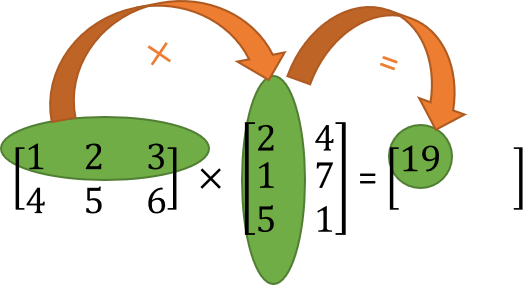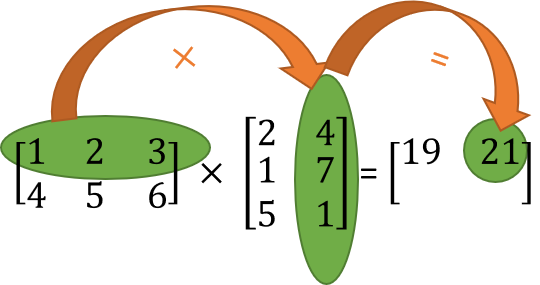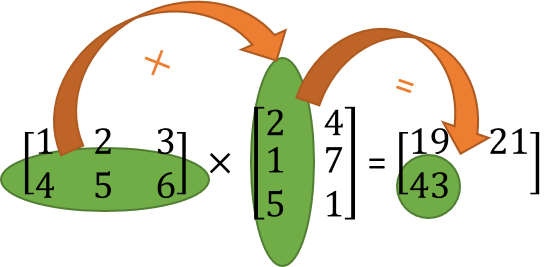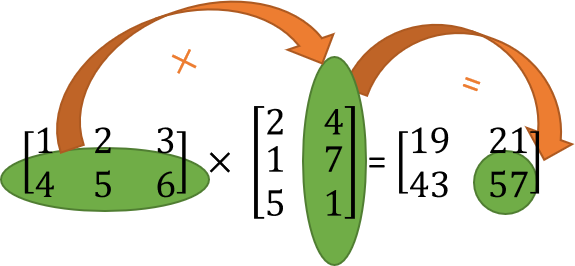Multiplication of Matrices
We already know the basics of Matrices. Now, in this article, we will study the concept of multiplication of metrices in detail.
Can we multiply two matrices?
Yes, we can. We can multiply a matrix by a constant (called scalar multiplication), and we can also multiply two matrices.
But we cannot multiply any two given matrices. They should fulfil some conditions. Let’s see.
Conditions for Multiplication of two Matrices
We can multiply two matrices only if they fulfil the following condition.
The number of columns in the first matrix, must be the same as the number of rows in the second matrix.
So, we can multiply the following two matrices (called dot multiplication):
$\begin{bmatrix}
1 & 2 & 3 \newline
4 & 5 & 6
\end{bmatrix}$ ×
$\begin{bmatrix}
2 & 4 \newline
1 & 7 \newline
5 & 1
\end{bmatrix}$
The first matrix has 3 columns and the second matrix has 3 rows.
Now, without further ado let’s see how to multiply two matrices.
Multiplication of two Matrices
We multiply two matrices using Dot Multiplication.
To get the first number of the resultant matrix, we multiply the numbers of the first row of first matrix, with the corresponding numbers of the first column of second matrix.
That’s how we start, and then we move ahead as per the size of the matrices. We can understand it much better via some examples.
Q. Multiply the following two matrices, and find the resultant matrix.
$\begin{bmatrix} 1 & 2 & 3 \newline 4 & 5 & 6 \end{bmatrix}$ × $\begin{bmatrix} 2 & 4 \newline 1 & 7 \newline 5 & 1 \end{bmatrix}$
Explanation:
The first matrix is 2 × 3, and the second matrix is 3 × 2. So, we can multiply these matrices.
First element
To get the first element of the resultant matrix, we need to multiply the numbers of the first row of first matrix, with the corresponding numbers of the first column of second matrix.

So, the first element = (1 × 2) + (2 × 1) + (3 × 5) = 2 + 2 + 15 = 19
Second element
To get the second element of the resultant matrix, we need to multiply the numbers of the first row of first matrix, with the corresponding numbers of the second column of second matrix.

So, the second element = (1 × 4) + (2 × 7) + (3 × 1) = 4 + 14 + 3 = 21
Third element
To get the third element of the resultant matrix, we need to multiply the numbers of the second row of first matrix, with the corresponding numbers of the first column of second matrix.

So, the third element = (4 × 2) + (5 × 1) + (6 × 5) = 8 + 5 + 30 = 43
Fourth element
To get the fourth element of the resultant matrix, we need to multiply the numbers of the second row of first matrix, with the corresponding numbers of the second column of second matrix.

So, the fourth element = (4 × 4) + (5 × 7) + (6 × 1) = 16 + 35 + 6 = 57
Now, since the first matrix was 2 × 3, and the second matrix was 3 × 2, the resultant matrix we got is 2 × 2.
Now, let us see some properties related to multiplication of two metrices.
Properties related to Multiplication of Metrices
Property 1: Order of Multiplication
Unlike arithmetic multiplication, the order of multiplication can make a difference in case of metrices. In other words, we can say that Commutative law of multiplication is not true in case of multiplication of matrices.
So, if A and B are two numbers, then we can say that A × B = B × A. For example, 4 × 5 = 5 × 4 (Commutative law of multiplication)
However, if A and B are two metrices, then we cannot say that A × B = B × A. In fact, many a times we even won’t be able to multiple them in opposite order, and even if we can then in most of the cases the resultant matrix would be different.
For example, if A = $\begin{bmatrix} 1 & 2 & 3 \newline 4 & 5 & 6 \end{bmatrix}$ and B = $\begin{bmatrix} 5 \newline 7 \newline 8 \end{bmatrix}$ , then:
- We can find A × B, as A has 3 columns and B has 3 rows. So, we can multiply them.
- However, we cannot find B × A, as B has 1 column and A has 2 rows.
If A = $\begin{bmatrix} 1 & 2 \newline 4 & 5 \end{bmatrix}$ and B = $\begin{bmatrix} 0 & 3 \newline 6 & 7 \end{bmatrix}$ , then:
A × B = $\begin{bmatrix} 12 & 17 \newline 30 & 47 \end{bmatrix}$
B × A = $\begin{bmatrix} 12 & 15 \newline 34 & 47 \end{bmatrix}$
As you can see, the resultant matrices are different in the two cases.
Property 2: Identity Matrix
Identity matrix is a square matrix, wherein all the diagonal elements are 1 and the rest of the elements are 0. It is denoted by the symbol I.
For example, $\begin{bmatrix} 1 & 0 & 0 \newline 0 & 1 & 0 \newline 0 & 0 & 1 \end{bmatrix}$ is a 3 × 3 identity matrix.
If we multiply any matrix (say A) with an identity matrix, then we get the same resultant matrix A. So, A × I = A
For example, $\begin{bmatrix} 1 & 2 \newline 4 & 5 \end{bmatrix}$ × $\begin{bmatrix} 1 & 0 \newline 0 & 1 \end{bmatrix}$ = $\begin{bmatrix} 1 & 2 \newline 4 & 5 \end{bmatrix}$
And if we can multiply them in reverse, then that will be equal to A too, i.e. I × A = A
For example, $\begin{bmatrix} 1 & 0 \newline 0 & 1 \end{bmatrix}$ × $\begin{bmatrix} 1 & 2 \newline 4 & 5 \end{bmatrix}$ = $\begin{bmatrix} 1 & 2 \newline 4 & 5 \end{bmatrix}$